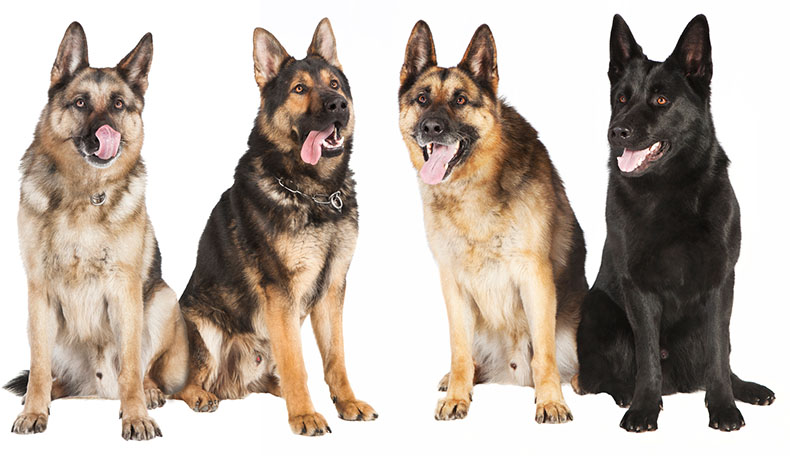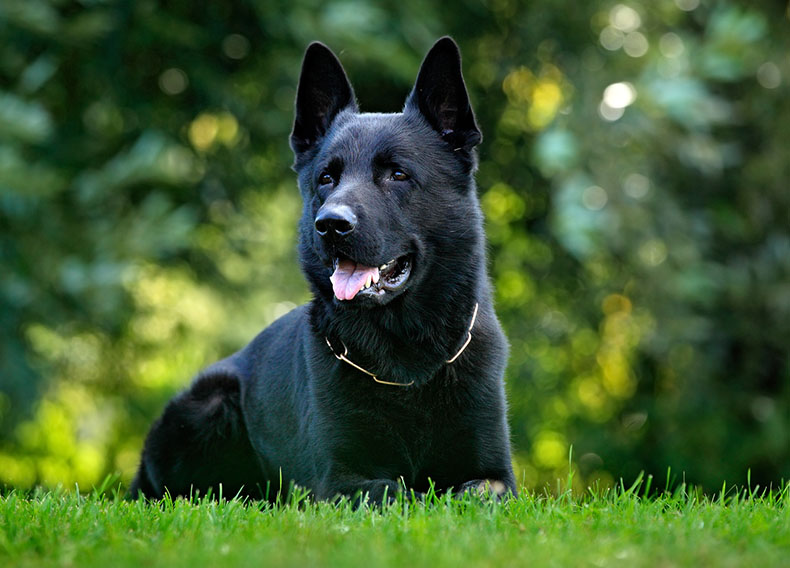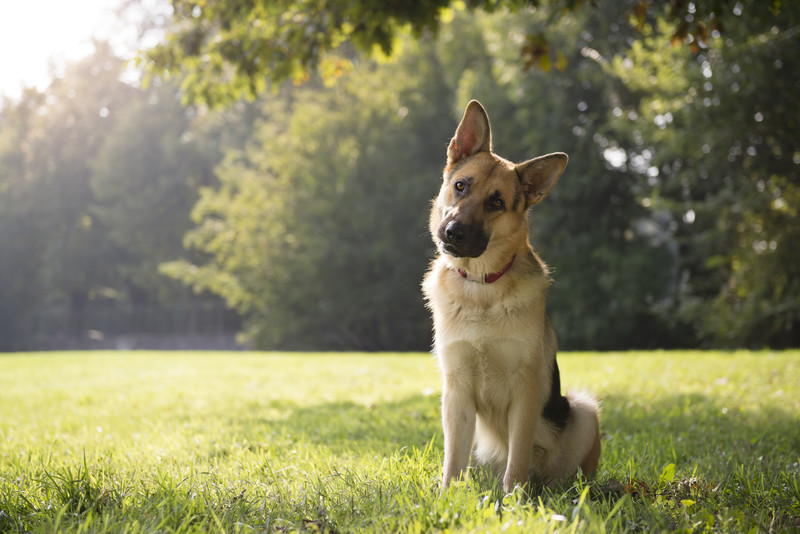What Colors Do German Shepherds Come in
German Shepherds are a working breed, and their coat comes equipped with a variety of features to help them do their job.
We can assist their natural protection by learning how to care and supplement their coat.
German shepherd coats also come in a huge variety of colors and lengths.
While some colors are rare and beautiful, some varieties are considered fault colors. And these faults are not officially recognized by the American Kennel Club.
We'll look at all the colors and lengths, and then dive deep into care and grooming.
The Truth About Single and Double Coated
German Shepherds are typically a Double Coated breed, meaning they have two layers of fur:
A top layer called the Guard coat (sometimes called top coat) that is slightly more "wiry" and abrasive.
Underneath you'll find a softer and light colored under-layer called the Undercoat.
Combined these layers are used to regulate body temperature, protect from harmful UV rays, repel water, and protect their skin.
What About Single Coats?
Although it's quiet rare – some German Shepherds are considered Single-Coated.
In the dog show ring we refer to them as "Smoothies", or Smooth-Coated Shepherds.
Technically, they still have both layers, but the undercoat is so sparse they're considered as single coated.
Note: Single coated German Shepherds are considered a breed fault, and not recognized by the AKC. Therefore, many years of selective breeding have made single coated litters a rare occurrence.

Can You Shave a German Shepherd?
The undercoat is a fantastic insulator, and you've probably guessed that it keeps them warm in the colder months. But those layers of fur also keep them cool in the summer, and insulate them from warm air.
This is why it's very bad practice to shave a doubled coated breed.
You won't be doing them any favors by getting rid of the very thing that regulates their body temperature, and protects their skin from abrasions and harmful UV rays.
German Shepherd Coat Colors
When you think of a German Shepherd, an image of the typical black and tan one from the movies you've watched probably pops up in your head.
But you'd be surprised to know that these gorgeous canines actually come in a much larger variety of colors and patterns.
The color of their coat depends on its genes. Genes that are dominant are the more common ones you see, while genes that are recessive are rare.
Some colors are considered faults and are not recognized by the AKC. But unless you're planning to show your dog in competitions, this won't cause any problems for you.
Do Colors Change Their Temperament?
There's a common myth that certain colors or hair lengths affect their personality or behavior. But there is absolutely no difference when it comes to purebreds. Whether your dog is red, blue, black, or white, you're still getting a standard German Shepherd.

Common Colors
- Black and Tan
- Black and Red
- Black and Silver
- Black and Cream
- Bi-Color
- Sable
- Black
Rare Colors
- White
- Blue
- Panda
- Liver
AKC Fault Colors
- Blue
- White
- Panda
- Liver
- Any pale or washed-out looking colors
Black and Tan

This is the most common color pattern – which is usually black all over, with tan or cream-colored chest and legs. They also have their accent color extending from their neck to their tails and underneath their bellies.
There are many color variations of this pattern, most commonly: Black and Red, Black and Cream, and Black and Silver.
Bicolor

Also considered a variation of the black and tan, bicolored dogs have smaller patches of accent color. They're usually solid black. with gold or brown on their feet, chest, and beneath their tail. Sometimes these accent colors extend to their face, jaw, inner ears, and eye brows.
Sable

Sable-colored shepherds tend to have bands of colors in their fur. Basically, their coat is made of strands of various colors like brown, black, silver, and red. These bands usually have a layer of black hair over them.
The most common sable combination is black hair over cream bands. Some even have gray over silver or black over silver combinations, which actually makes them look a lot like wolves.
Solid Black

Black is uncommon (due to being a recessive gene) but still prevalent within the breed. Typically they are completely black with no other colors on their body. But sometimes, they have a few white patches on their chests.
Solid White

As you might expect, these dogs are completely white throughout their body. Although majestic looking, it's still considered a faulty trait by most kennel standards.
The white is actually a genetic defect that masks all the black parts of the dog. Since this is undesirable in dog shows, they are rarely bred.
But some enthusiasts do still breed them, and are now called by a variety of names such as the White Swiss Shepherd and the American-Canadian White Shepherd. You can learn more about dog breeds that look like German Shepherds (or descended from).
Blue

"Blue" is often used for a dusty or somewhat light grey, and a grey leather nose. Sometimes these puppies are born with very light eyes as well. This too is a rare recessive gene, and considered a fault color by AKC.
Liver

Liver is another recessive gene leading to liver-colored offspring. In dogs like this, all the black parts are a brown or liver color, ranging from light to dark shades. They may also have light eyes, which typically changes into a darker color later in their lives.
Panda

They are highly debated on their origin, and considered a fault by the AKC. There is no shortage of controversy with the Panda Shepherd. However, new research confirms this was not the result of crossbreeding.
In any case, the very unique looking Panda pattern has white on at least 30% of their body, mixed with patches of black and brown features. Combined this gives them the distinctive "Panda" look.
German Shepherd Coat Length
1. Short Haired

Short Hair length = 1 inch long or less.
Shorter hair is ideal for working conditions as it won't get caught or reduce their vision/movement in the line of duty.
So basically, any service dog, police dog, or military dog you see is usually short-haired.
2. Medium Length "Plush"

Medium Hair Length = 1 to 2 inches long.
Somewhere in between Short and Long coats lies the Medium Length. Sometimes referred to as "Plush", this is the most desirable length by AKC standards.
3. Long Haired

Long Hair Length = Longer than 2 Inches
These dogs usually have thick, soft, and silky coat hair that is two inches or longer. The long hair grows around their faces, tails, ears, tummies, rear, and the back of their legs.
That also means there is a lot more grooming requirements. Their hair is prone to matting, and requires daily brushing. However, shaving them is dangerous as this is a double coated breed.
Long haired GS's are considered a disqualifying fault by the AKC for showing purposes.
The AKC Standard Dilemma
All the coat colors and lengths mentioned above are considered to be purebred, but the American Kennel Club (AKC) doesn't recognize certain features.
This clearly shouldn't matter, because these are just some beauty standards set by the AKC, right?
Well, this verdict has led most people to breed certain types of German Shepherds. If your dog is strictly a pet, then this has no bearing on your decision. However, if you plan to breed or show your dog, then you'll want to consider their guidelines.
Here are some AKC Guidelines with German Shepherd Coats:
- Strong, Rich Colors Preferred.
- Pale, washed-out colors are disqualifying.
- Blue, Liver, White, and Panda are all instant disqualifying faults.
- Long haired German Shepherds may also be disqualified.
- Blue eyes are a fault.
Shedding
Many owners refer to them as "German Shedders" – so you probably know already that these dogs will shed like crazy.
Due to primarily being a working dog, they had to work in all sorts of weather conditions. The result: daily excessive shedding that helped keep their coats in the best condition.
Unfortunately for you that means a lot more brushing and bathing.
Shedding Season
Although these canines shed throughout the whole year, they shed most heavily in spring and autumn. This is known as their "shedding season," or when their coat is "blown."
In summer, the thick undercoat is shed and replaced with a thinner undercoat. This helps them regulate their body temperate and stay cool in the heat.
Again, during autumn, the thin summer undercoat is shed away and replaced by a thicker coat. This is their winter insulation to keep them warm in the cold months ahead.

Grooming & Care
Daily brushing and bathing are still the best deshedding methods, and for keeping their hair healthy and beautiful.
Thankfully, we had an expert groomer chime in and tell us all her shop secrets for shedding German Shepherds. You can check that out here.
But if you're in a hurry, here's a quick overview:
Brushing
Double coated breeds need to be brushed at least three to four times a week (and everyday during shedding season).
While regular brushing removes loose hair, it also gets rid of mats and tangles, which are a common sight in long and medium length coats.
Although they don't seem like a big deal, mats can be pretty painful, with hair tugging from all sides.
In most cases we recommend an undercoat rake for brushing and reducing shedding. Longer hair lengths would also benefit from a grey hound comb (a long pinned steel comb).
Bathing
The occasional bath can help get rid of that last 20% of shedding hair that never seems to go away.
The trick is to use a deshedding shampoo and conditioner to help slick down hairs and make them easier to remove.
Here's another pro tip: after their bath, while they're still a little bit damp, brush out their entire coat. The slicked down hairs will dislodge much easier and leave them shed free for a week.
How Often Should You Bathe Them?
The short answer: As little as possible.
The long answer: It depends. Speaking with groomers on the topic, they recommend a healthy double coated dog be bathed once they start to get stinky. This is typically once every 8 weeks.
Bathing too often can strip away their natural oils, leading to dry and irritated skin.

Nutritional Requirements for a Healthy Coat
Since German Shepherds are large breed dogs with active lifestyles, they need a protein-based diet. The main ingredients should be sourced from high-quality meat such as poultry, beef, and fish.
Their food should also contain 5 to 8% fat, according to AAFCO recommendations. This is an extremely important part of their diet because fat strengthens skin and hair follicles.
The best dog food for German Shepherds always contains ingredients that promote healthy coat and skin.
Skin and Coat Friendly Ingredients
To make sure your German Shepherd has a healthy coat, here are some of the things you should look out for in its food:
Vitamins A and E
Vitamin A is one of the most important vitamins your dog should be getting in its diet. This vitamin helps the skin cells to divide and hair follicles to function normally.
Vitamin E is also in the essentials list. It acts as an antioxidant and protects the skin cells. Both of these vitamins ensure that their coat keeps growing and shedding as usual on a micro level.
Vitamin B Complex
Biotin, or the B- complex vitamin, is also incredibly important for skin and hair strength. Some young dogs and puppies can actually suffer from a biotin deficiency.
When this happens, your dog will have crusty and flaky skin. Its hair will become more brittle and lose its natural color. If you see these symptoms, contact your vet about adding some biotin to their diet.
Copper and Zinc
Your dog's food should also contain copper and zinc. Copper is essential in keeping their fur soft and shiny. It also maintains the unique hair color that it was born with.
Zinc, on the other hand, works with developing skin health. It helps to prevent inflammation and itchiness. It also works well at tackling and stopping both bacterial and fungal infections.
Omega 6 & 3 Fatty Acids
Omega 6 and 3 fatty acids are the ultimate ingredients for your dog's skin and fur. They keep your dog's hair looking glossy and help the skin to stay elastic.
Contact Your Vet
Before supplementing, always contact your vet before hand. A good, balanced dog food will have all these vitamins present, so in most cases you won't have to add additional vitamins.
Guest
Related Posts
What Colors Do German Shepherds Come in
Source: https://www.playbarkrun.com/german-shepherd-coat-colors-length/
1 thought on "German Shepherd Coat – [Colors, Length, & Care]"
The German Shepherd is such a beautiful dog, he's balanced in all ways. My favorite is the iconic bicolor, although I really love the Blue and Liver ones, they look so special, too bad they aren't recognized by the AKC so you can't participate with them in an official competition where pure breeds are a must.
Reply